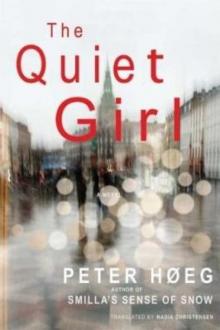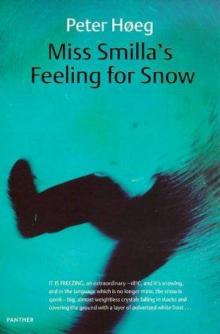- Home
- Peter Høeg
Smilla's Sense of Snow Page 15
Smilla's Sense of Snow Read online
Page 15
It looks as if he has done historical research on several occasions. There’s an article on the examination of the Iron Age bog people. And there are three articles I put a check mark next to. They deal with the examination of mummies by X-ray. One of them was carried out in Berlin in the seventies, at the Pergamon Museum, on mummies from Tutankhamen’s tomb. The second one deals with pre-Buddhist embalming methods in Malaysia and Thailand, published by a museum in Singapore. The third is a treatise on the Greenlandic Qilakitsoq mummies.
At the bottom of the list I write: “With thanks—Smilla,” put it in an envelope, and address it to my father. Then I go through the clippings.
There are eighteen of them, and they’re in chronological order. I start with the most recent. There’s an article from October, announcing that preparations are now nearly complete for the establishment of a forensic medical office for Greenland under the leadership of Professor Johannes Loyen, M.D. The next one is from a year earlier. There’s a photo with a brief caption: “The ethics council at the conference in Godthåb.” Wearing kamiks and fur hats. Loyen is second from the left. He towers as high as those standing behind him a couple of steps up. The next one is from his seventieth birthday the year before. The text says that due to his work with an autopsy center for Greenland, they have made an exception and extended his tenure. The articles continue this way, backward in time. “Congratulations on your sixtieth, Professor Loyen.” “Professor Loyen lectures at Greenland’s newly opened university.” “Representatives from the board of health in Greenland, Copenhagen’s chief medical officer to the left, and chief of staff J. Loyen, head of the newly established Institute for Arctic Medicine.” And so on, backward through the seventies and sixties. The expeditions of ’91 and ’66 are not mentioned.
The next-to-last clipping is from 1949. It’s a little piece of verbal prostitution. An enthusiastic description of the Cryolite Corporation of Denmark’s new dumpsters, which have eased the transport of ore from the deeper sections of the quarry up to the earth’s surface. A heartfelt tribute to Councilor Ebel and his wife, who are pictured in front. Behind stand chief engineer Dr. Wilhelm Ottesen and the corporation’s medical consultant, Dr. Johannes Loyen. The photo was taken at the quarry in Saqqaq, at the moment when the new machines brought the first load to the surface.
After this picture there’s a gap of ten years. The last clipping is from May 1939.
It’s a photo with a caption. The picture was taken in a harbor. A dark ship is in the background. About a dozen people are standing in the foreground. Gentlemen in lightweight suits, women in long skirts and thin wraps. The setting makes it seem staged. The caption is quite brief: “The courageous and enthusiastic company from Freia Film upon departure for Greenland.” Then follows a list of the courageous and enthusiastic company. It consists of actors and a director, the film company’s doctor and his assistant. The doctor’s name is Rovsing. The assistant is unnamed. Assistants didn’t have names in the conservative press in the thirties. But his later career has preserved this photo as well in an archive, and prompted someone to add his name with a ballpoint pen. He’s visible in the photograph. Taller than everyone else. And in spite of his youth, his subordinate position, and his spot behind eccentrics pandering to the camera, his arrogance shines through even then. It’s Loyen. I fold up the clipping.
After breakfast I put on a long suede coat and the Jane Eberlein fur hat. The coat has deep inside pockets. Into them I put the last, folded clipping, a bundle of krone notes, Isaiah’s tape, and the letter to my father. Then I leave. The day has begun.
At Pronto Print on Torve Street I have a copy of the tape made. I also borrow their phone book. The Institute for Eskimology is located on Fiol Lane. I call them from the phone booth on the square. I’m transferred to an instructor who sounds as if he is of Greenlandic extraction. I explain that I have a tape in East Greenlandic that I can’t understand. He asks me why I don’t go over to the Greenlanders’ House.
“I want an expert. It’s not just a matter of understanding what is said. I want to try to identify who is speaking. I’m looking for someone who can listen to the voice and tell me that the speaker has henna-dyed hair and was spanked as a five-year-old when he was sitting on the potty, and from his vowels it sounds as if this happened in Akunnaaq in 1947.”
He starts chuckling to himself.
“Do you have money, madam?”
“Do you? And it’s not madam. It’s miss.”
“Svajer Wharf. It’s on the South Harbor. Berth number 126. Ask for the curator.”
He’s still chuckling as he hangs up.
I take the train to Enghave Station. From there I walk. I’ve had a look at Krak’s Map of Copenhagen at the library on Torve Street. In my mind I have an image of a labyrinth of winding streets.
The station is cold. A man is standing on the opposite platform. He’s staring longingly toward the train that will take him away, into the city, into the crowds. He’s the last person I see.
Right now the inner city is like an anthill. Now people are crowding into the department stores. They’re getting ready for theater premieres. They’re standing in line in front of Hviid’s Wine Cellar.
The South Harbor is a ghost town. The sky is low and gray. The inhaled air tastes of coal smoke and chemicals.
Anyone who is afraid that machines will soon take over should not take a stroll in the South Harbor. The snow hasn’t been cleared away. The sidewalks are impassable. Now and then enormous double semis with dark windows devoid of any humans move along the narrow, plowed roads. A blanket of green smoke hovers over a soap factory. A cafeteria advertises hash browns and sausages. Behind the windows red and yellow lights shine on lonely deep-fat fryers in an empty kitchen. Above a snowy pile of coal a crane moves aimlessly and restlessly back and forth on its rails. There are bluish glimmers through the cracks in closed garage doors, and the crackling of arc welders, and the jingling of the illegal money being earned, but no human voices.
Then the road opens onto a picture postcard: a large harbor basin surrounded by low yellow warehouses. The water is iced over, and while I’m still taking stock of the view, the sun appears, low, white-gold, surprising, and lights up the ice like an underground bulb behind frosted glass. There are small fishing boats at the wharf with blue hulls the color of the sea where it meets the horizon. On the outer edge of the basin, out in the harbor itself, there is a big three-masted sailing ship. That’s Svajer Wharf.
Berth 126 is the sailing ship. I don’t meet a soul on the way. All the machine sounds have disappeared behind me. Everything is quiet.
A post is sticking up from the wharf with a white mailbox on it. Above is a large sign, still wrapped in white plastic.
On the stern it says in gilded letters that the ship’s name is Northern Light. It has a figurehead carved like a man holding a torch; it has a shiny black hull at least a hundred feet long, masts that tower up to the sky and give the impression that you’re standing in front of a church, and a smell of tar and sawdust. Someone has recently spent a fortune renovating it.
I go on board via a gangway with a thick coir mat and railings with polished bronze knobs. The entire deck is filled with big wooden crates marked FRAGILE and stacks of planks and paint cans. All the ropes are meticulously coiled up, all the wood has the deep, dark brown sheen of a dozen layers of expensive ship’s lacquer. The white enamel shines like glass. The air shimmers with polish, two-component epoxy, and joint paste. Aside from this shimmering, the ship is apparently deserted.
A narrow ladder between the crates leads to a lacquered double door that isn’t locked. Beyond the door a companionway descends into the darkness.
A man is standing at the bottom of the steps. He’s leaning on a spear, and he doesn’t move. Not even when I’m quite close to him.
The room must have several skylights that are still covered. But along the edges of the covers, thin stripes of white light filter in. Enough so that I can see it’s a big h
all. All the dividing walls have been torn out to create an area that is about eighty feet long and just as wide as the ship.
Now there is enough light for me to see that the man in front of me is an Inuit. What he’s leaning on is a long harpoon. In his left hand he’s holding a dart thrower. He is only partially dressed, in high kamiks and an inner coat of bird skin. He isn’t much taller than me. I pat him on the cheek. He is cast from hollow fiberglass and then cleverly painted. His face is alert.
“Lifelike, isn’t it?”
The voice comes from somewhere behind a screen. On my way over to it I have to go around a kayak that is still partially wrapped and a glass counter lying there like an empty 800-gallon aquarium. The screen is a hide stretched between two whalebones. Behind it is a desk. Behind the desk sits a man. He stands up and I shake his proffered hand. He looks exactly like the mannikin. But he’s thirty years older. His hair is thick and cut pageboy-style, but gray. His background is like mine. Greenlandic in some way.
“You’re the curator?”
“Yes, I am.”
His Danish is without accent. He gestures with his hand.
“We’re in the process of setting up the collection. It cost a fortune.”
I place the tape in front of him. He touches it cautiously.
“I’m trying to identify the man speaking. I found my way over here by calling the Institute for Eskimology.”
He smiles with satisfaction. “Word of mouth is the best advertisement. And by far the cheapest. Do you know what it costs to advertise?”
“Only personal ads.”
“Is that expensive?”
He is sincerely interested. Humor is wasted on him.
“Very.”
He nods. “It’s terrible. They clean you out. The newspapers. The tax system, the customs office …”
It seems to me that I’ve seen him before. It’s a feeling that I get from faces and places more and more often. I don’t know whether it’s because I’ve seen so much that the world is starting to repeat itself, or whether it’s due to premature wear and tear on the mental apparatus.
He has a square, flat, matte-black cassette tape recorder on the table in front of him. He puts in the tape. The sound comes from distant speakers on the perimeter of the room. Now that my eyes are becoming adjusted to the darkness, I can sense the way the walls curve along with the sides of the ship.
He listens for half a minute with his head in his hands. Then he stops the tape.
“Mid-forties. Grew up near Angmagsalik. Very little formal education. On top of the East Greenlandic there are traces of more northern dialects. But up there they move around too much to say which exactly. He has probably never been away from Greenland for any appreciable length of time.”
He looks at me with light-gray, almost milky eyes, with an expression as if he’s waiting for something. Suddenly I know what it is. It’s the applause after the first act.
“Impressive,” I say. “Can you tell me more?”
“He’s describing a journey. Across ice. With sleds. He’s probably a hunter, because he uses a series of technical terms, such as anut for the dog harnesses. He’s probably talking to a European. He uses English names for locations. And he seems to think he has to repeat many things.”
He listened to the tape for a very short time. I wonder whether he’s pulling my leg.
“You don’t believe me,” he says coldly.
“I just wonder how you can conclude so much from so little.”
“Language is a hologram.”
He says this slowly and firmly.
“In every human utterance lies the sum total of that person’s linguistic past. Now, you yourself … You’re in your mid-thirties. Grew up in Thule or north of there. One or both parents Inuit. You came to Denmark after assimilating the entire linguistic foundation of Greenlandic, but before you lost the child’s instinctive talent for learning a foreign language perfectly. Let’s say you were between seven and eleven years old. After that it gets harder. There are traces of several sociolects. Perhaps you lived or went to school in the northern suburbs, Gentofte or Charlottenlund. There is also a trace of a North Sealand accent. And strangely enough, even a later hint of West Greenlandic.”
I make no attempt to hide my astonishment.
“That’s true,” I say. “It’s all basically true.”
He smacks his lips in satisfaction.
“Is there any possibility of determining where the conversation took place?”
“You really can’t tell?”
I notice it again. His bold self-confidence and his sense of triumph at his knowledge.
He rewinds. He doesn’t look at the tape recorder while he’s handling it. He plays about ten seconds for me.
“What do you hear?”
I hear only the incomprehensible voice.
“Behind the voice. Another sound.”
He plays it again. Then I hear it. The faint, escalating sound of a motor, like a generator starting up and then shut off.
“A prop plane,” he says. “A big prop plane.”
He fast-forwards. Turns it on again. A segment with the faint clatter of dishes.
“A large room. Low-ceilinged. Tables being set. Some kind of restaurant.”
I can see that he knows the answer. But he’s enjoying pulling it very slowly out of his top hat.
“A voice in the background.”
He plays the same segment several times. Now I can just make it out.
“A woman,” I say.
“A man talking like a woman. He’s yelling. In Danish and American English. Danish is his mother tongue. Presumably he’s yelling at the person setting the table. He’s probably the restaurant manager.”
One last time I wonder whether he’s just guessing. But I know he’s right. He must have an abnormally precise and skilled sense of hearing and a gift for languages.
The tape is playing again.
“Another prop plane,” I suggest.
He shakes his head. “A jet. A smaller jet. Quite soon after the previous plane. An airport with heavy traffic.”
He leans back.
“Where in the world can an East Greenlandic hunter sit and talk in a restaurant where the tables are being set, where a Dane is yelling in American English, and where you can hear an airport in the background?”
Now I know, too, but I let him tell me. Let little kids have their fun. Even grown-up kids.
“Only one place. At Thule Air Base.”
On the base the club is called the Northern Star. A restaurant in two sections, with a dance hall.
He starts the tape again. “It’s strange.”
I don’t say a word.
“The music … behind the voice … remnants from the previous recording. It’s pop, of course. ‘There Must Be an Angel’ by the Eurythmics. But the trumpet …”
He looks up.
“Of course you can hear that the piano is a Yamaha grand.”
I can’t hear any piano at all.
“A loud, heavy, flashy tone. A rather clumsy bass. Often a little off-key. Certainly no Bösendorfer … But it’s the trumpet that surprises me.”
“There’s some of the music left at the end of the tape,” I say.
He fast-forwards. When he presses the play button, we’re at a spot right after the music starts.
“Mr. PC!” he says. Then his face goes blank, self-absorbed.
He lets it play to the end. When he stops the tape, he seems very far away. I give him time to come back. He wipes his eyes.
“Jazz,” he says quietly. “My passion …”
It was a brief moment of letting down his guard. When he comes back, he’s as cocky as ever. Three-quarters of the politicians and bureaucrats who are part of the Home Rule belong to his generation. They were the first Greenlanders to get a university education. Some of them have survived and held on to their identities. Others—like the curator—with their fragile but abnormally overblown self-confidence, ha
ve become genuine, intellectual Northern Danes.
“It’s actually quite difficult to recognize a musician from the tone. Who can you identify this way? Stan Getz when he plays Latin-American style. Miles Davis from his naked, precise, vibrato-less sound. Armstrong by his meticulous crystallization of New Orleans jazz. And this musician.”
He looks at me, full of anticipation and reproach.
“Great jazz is synonymous with the John Coltrane quartet. McCoy Tyner on the piano, Jimmy Garrison on bass, Elvin Jones on drums. And in the periods when Jones was in prison: Roy Hanes. Just those four. Except on four occasions. The four concerts at the New York Independent Club. That’s when Roy Louber joined them on trumpet. He learned his sense for European harmonizing and his incantatory African nerve from Coltrane himself.”
We sit there for a moment thinking about this.
“Alcohol,” he says suddenly, “has never been good for music. Cannabis is supposed to be great. But alcohol is a ticking bomb under jazz.”
We sit there listening to the bomb ticking.
“Since that time in ’64, Louber has been working on drinking himself to death. On his way down, in both human and musical terms, he happened to come through Scandinavia. And he stayed here.”
Now I remember his name from concert posters. From certain scandalous newspaper headlines. One of them said: FAMOUS DRUNK JAZZ MUSICIAN TRIES TO TIP OVER CITY BUS.
“He must have been playing in the restaurant. It’s the same acoustics. The people eating in the background. Someone has seized the opportunity to make a pirate recording.”
He smiles, full of sympathy for such a project.
“They’ve managed to get themselves a free live recording. You can save a lot of money with a little Walkman. If you dare take the risk.”
“Why would he go to Thule?”
“Money, of course. Jazz musicians live on so-called bare-ass jobs. Imagine what it costs …”
“What costs?”

 The Woman and the Ape
The Woman and the Ape Smilla's Sense of Snow
Smilla's Sense of Snow Borderliners
Borderliners The Susan Effect
The Susan Effect The History of Danish Dreams
The History of Danish Dreams The Elephant Keepers' Children
The Elephant Keepers' Children The Quiet Girl - Peter Hoeg
The Quiet Girl - Peter Hoeg Smilla's Sense of Snow aka Miss Smilla's Feeling for Snow
Smilla's Sense of Snow aka Miss Smilla's Feeling for Snow